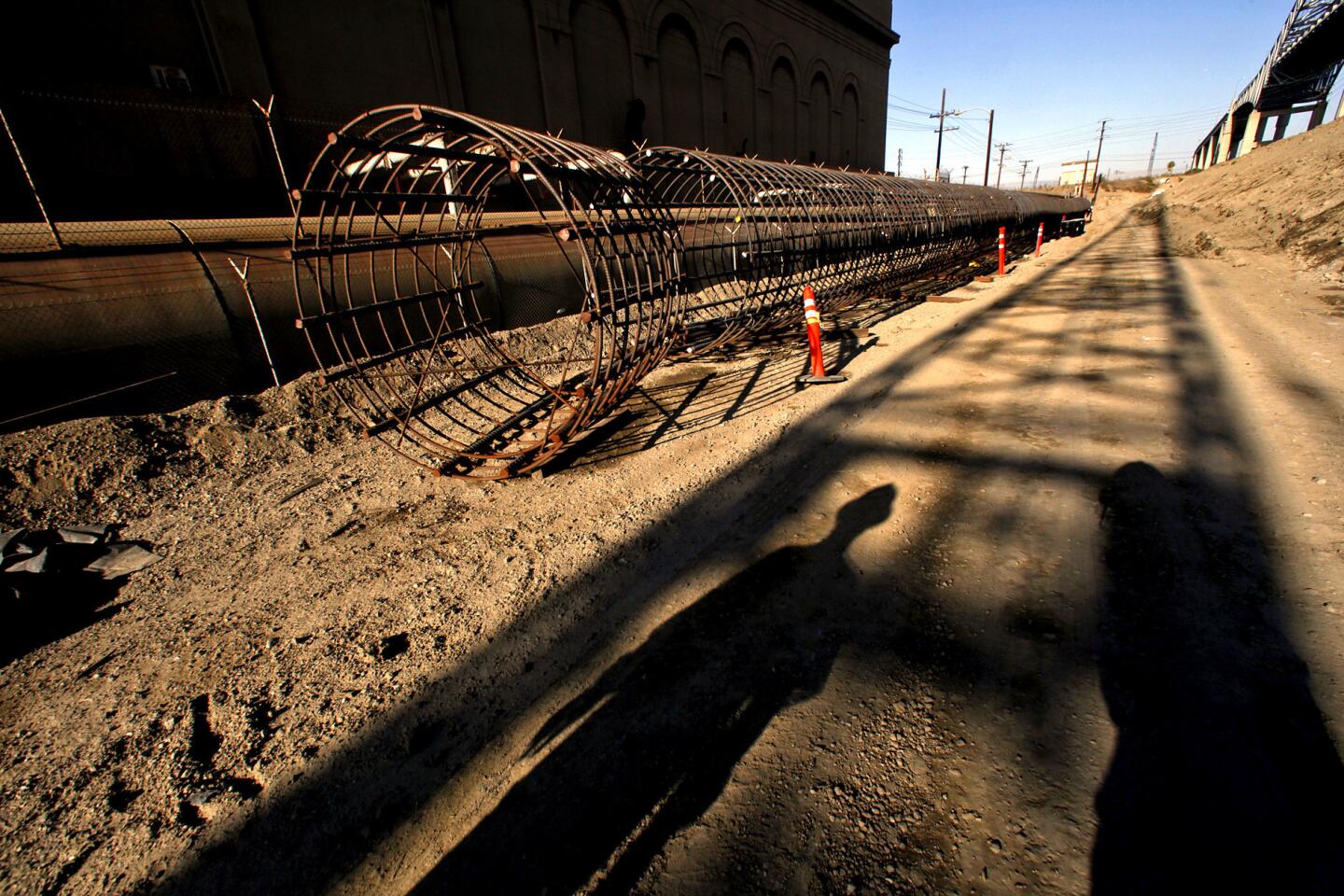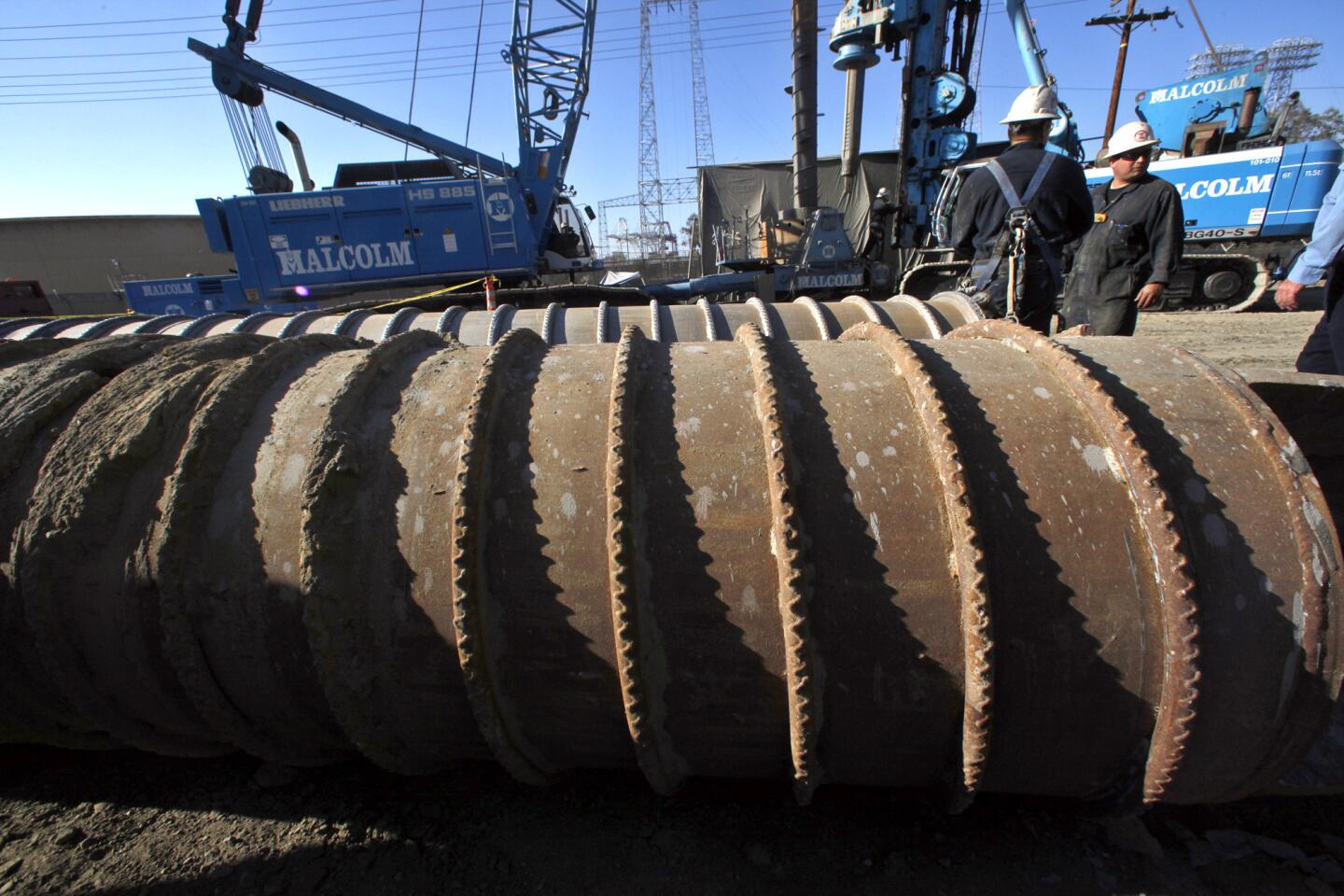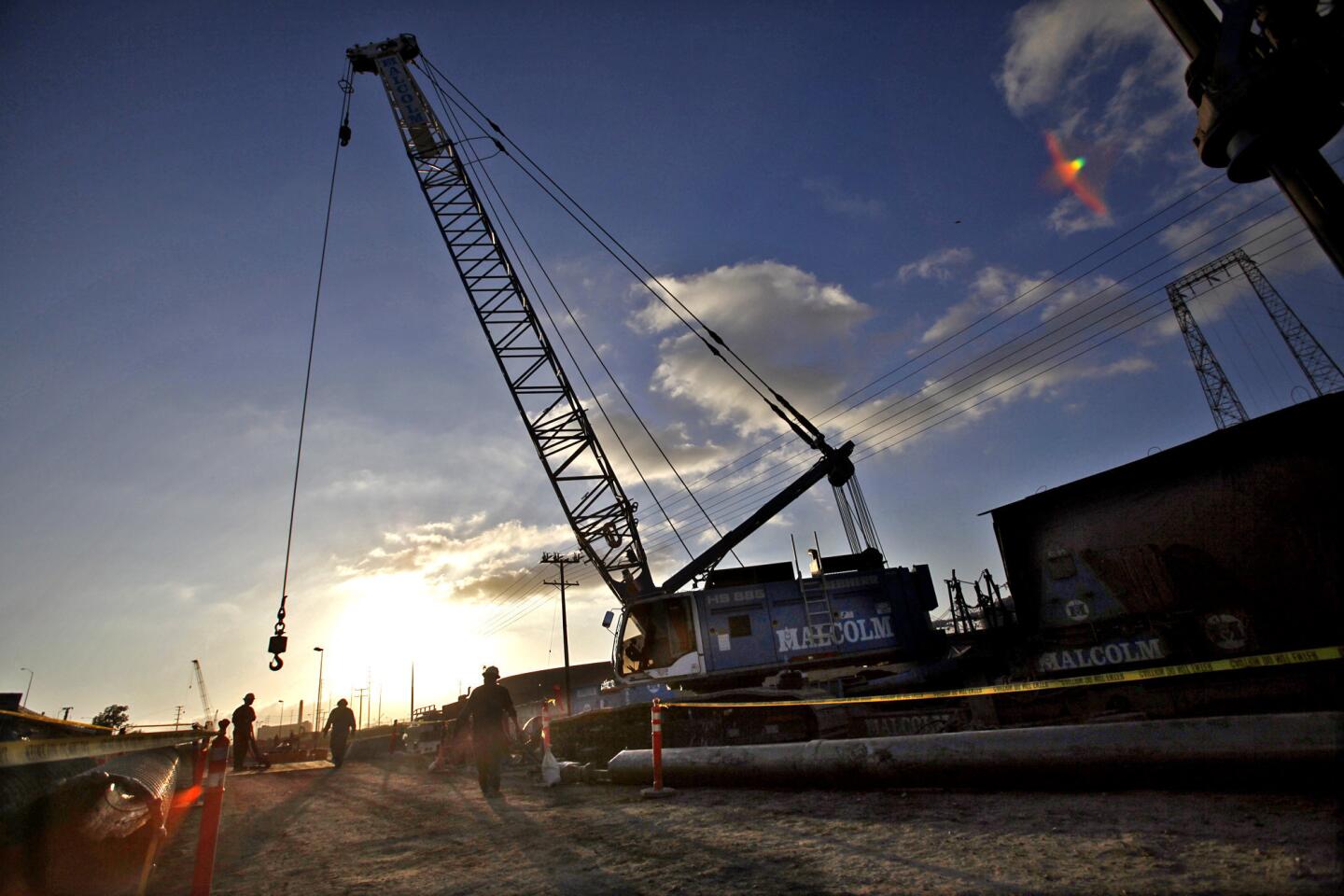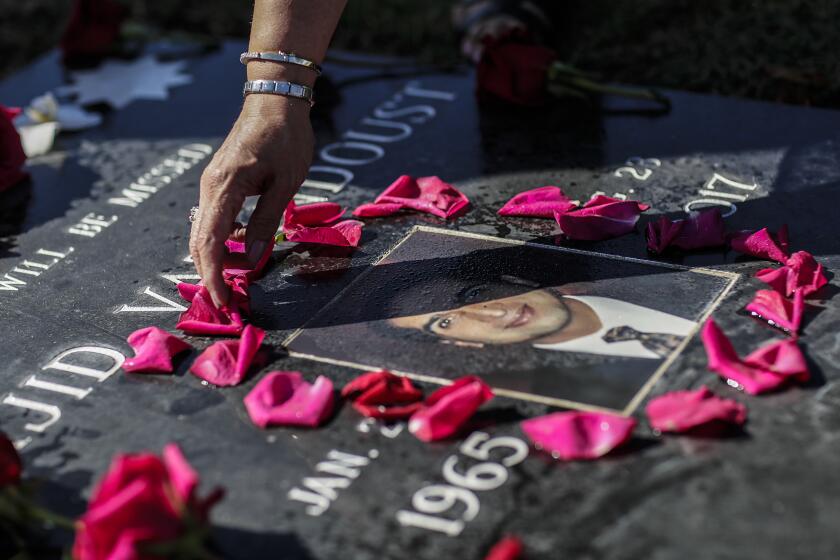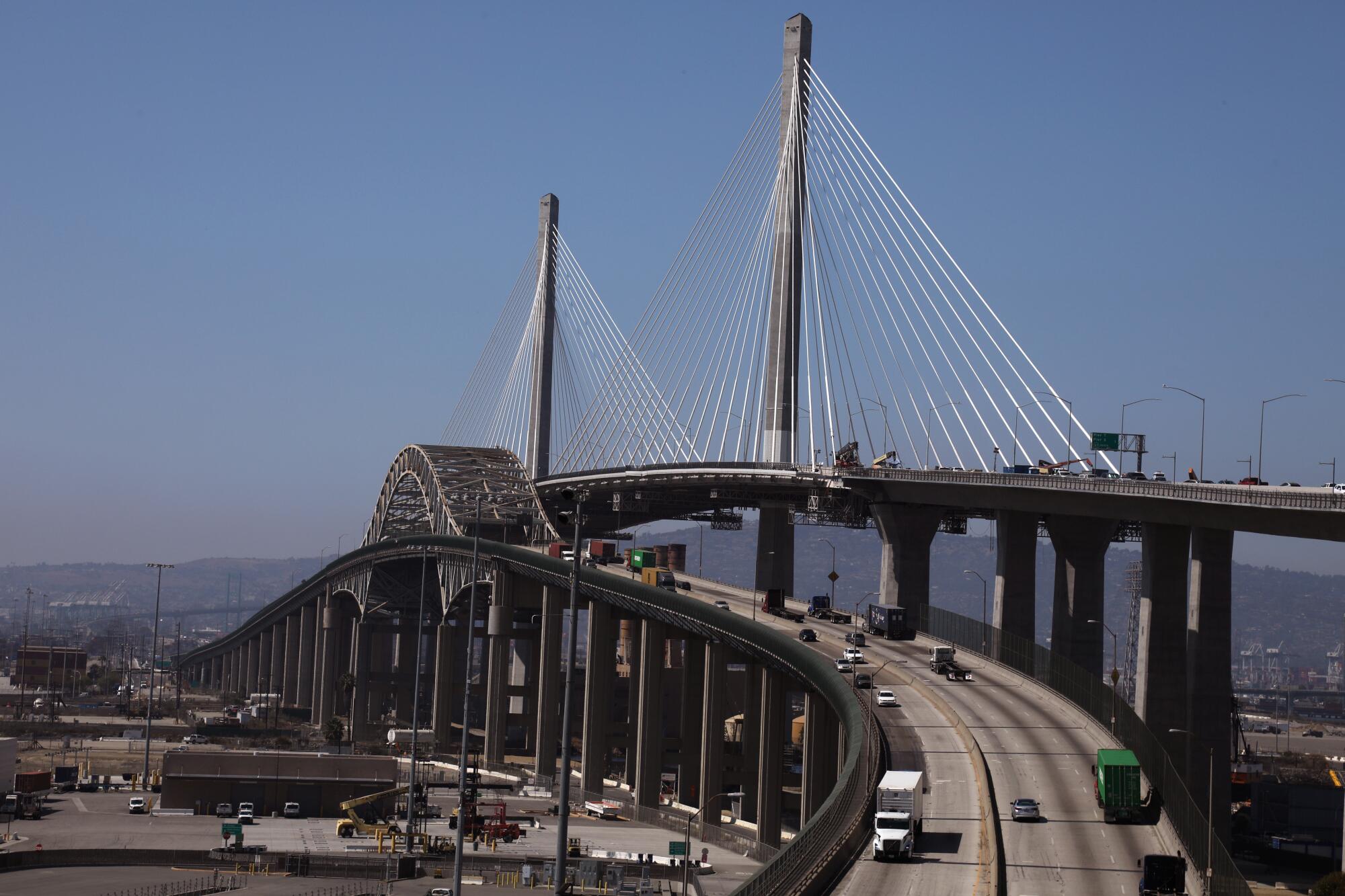
Fog hovers just above the new Gerald Desmond Bridge in Long Beach. Workers are scattered over a job site cluttered with traffic cones, construction vehicles and a few small cranes, and Duane Kenagy is giving a tour.
Since signing on as executive director for the project in 2014, Kenagy has grown accustomed to playing docent to an international cast of visiting politicians, students, bureaucrats and media.
Barring delays, the bridge will open Monday, and cars and trucks — by some estimates, 60,000 a day, now rattling across the old bridge just a few feet away — will sail over this gleaming new span connecting the 710 Freeway and downtown Long Beach to the nation’s busiest port complex.
“We’re in a mad dash to get everything done,” Kenagy said, even though with just 10 days to go he hardly seems hurried.
But then an engineer like Kenagy doesn’t manage a $1.47-billion project and coordinate the daily efforts of more 300 union workers over the course of six years without learning how to downplay stress.
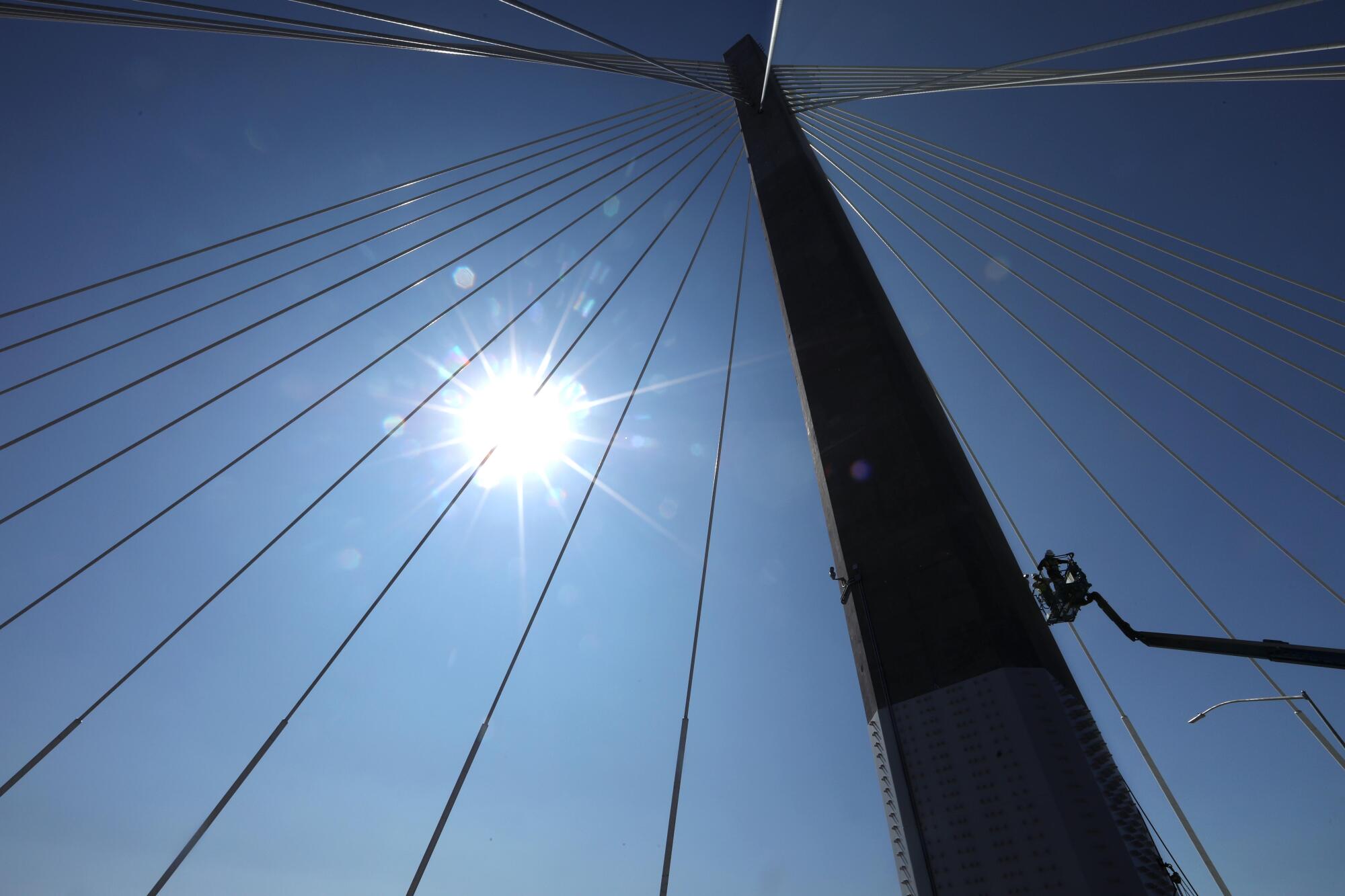
A worker in an aerial lift rises 30 feet off the roadway. He maneuvers beside one of the bridge’s 80 white cables that rise to the top of the twin towers. Up close, they look a little like the lines of a twirling skirt bundled at the waist.
Sponge in hand, he begins wiping the plastic sheathing that protects an intricate bundling of wire, the actual cables, inside. The solution is to prevent the writing of taggers from staining the surface.
The new Gerald Desmond Bridge is one of three construction projects with a billion-dollar-plus price tag completed in Los Angeles County in the last five years.
Like the tallest building, the Wilshire Grand, and the newest sports and entertainment complex, SoFi Stadium, the bridge provides the region with a glimpse of a future beyond its present-day problems: struggles in the streets, a global pandemic, unemployment, homelessness.
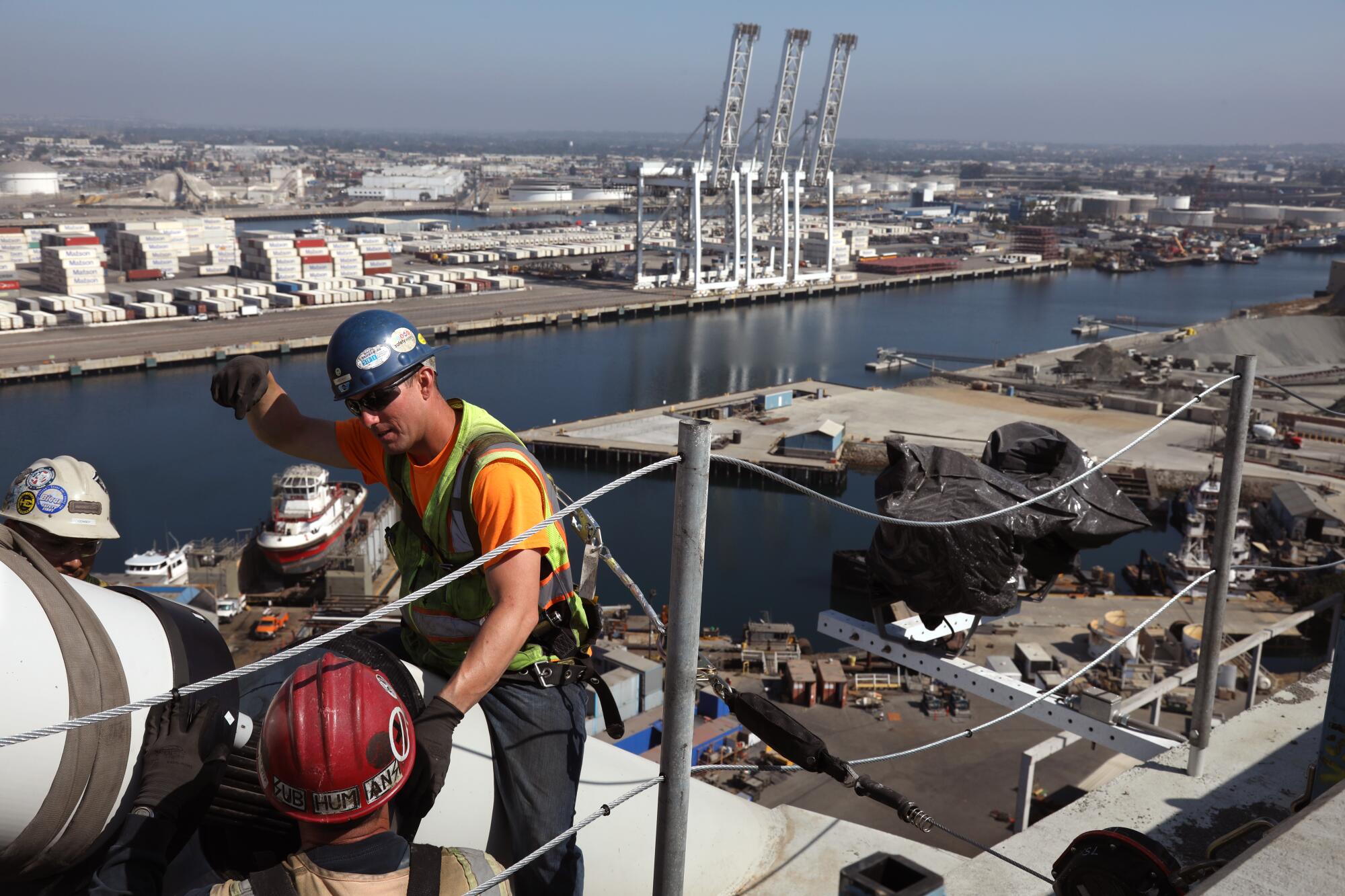
Construction is also underway on the $2-billion Crenshaw Line, the $4.5-billion people mover at LAX, the $588-million Sixth Street Bridge downtown.
While the immediate goal may be to showcase the region during the 2028 Summer Olympics, these projects will help define life in Los Angeles for generations.
Kenagy, 67, who came here in 1989 to work on the elevated roadway above the 110 Freeway and never left, summarizes such ambitions:
“We are an optimistic people living in an optimistic region.”
The bridge was conceived of a month after 9/11 and completed in a pandemic-occasioned recession. Its 19-year journey from blueprints to opening took it from wind tunnels in China to engineering studios in Germany, from a steel mill in Arizona to union halls in California.
Semyon Treyger was there from the start when the Port of Long Beach awarded his employer, the engineering firm HNTB, and Parsons Transportation Group the contract in 2001 to come up with a replacement for the existing bridge, which had opened in 1968 and was already obsolete.
Thousands of patients in L.A. County’s public hospital system face long, sometimes deadly waits to see specialists, a Times investigation has found. The system serves primarily the region’s poorest and most vulnerable residents.
Treyger, who was trained as a structural engineer in the Soviet Union and immigrated to the United States in 1979, began working with Danish bridge architect Poul Ove Jensen to solve a problem.
Container ships — the behemoths of modern commerce — were getting larger and unable to access terminals in the port’s back bay, except at low tide, because the existing bridge did not have the required clearance.

Before building a structure designed to last 100 years, Treyger and Jensen turned to the Danish Maritime Institute to find out how tall the tallest container ship would likely become. The answer — 203 feet from the waterline — established the first requirement for their bridge.
They would give it a 205-foot clearance, 50 feet — or six stacked shipping containers — taller than the old bridge.
They also wanted to situate the primary supports for the bridge — its two towers — 1,000 feet apart, almost five times greater than the width of the channel below. If the port wanted to expand that waterway, it could.
With these dimensions, they settled upon building what is known as a cable-stayed bridge, which gave them three advantages.
Unlike a suspension bridge — the Golden Gate, for example — a cable-stayed bridge does not require giant concrete anchors on the ground that support the two main cables slung over the top of the towers. The real estate on either side of the towers could be used for other purposes.
The construction of a cable-stayed bridge does not require a temporary structure rising from the ground to support construction of the roadbed. That would impede traffic under the bridge, and the business of the port needed to continue without interruption.
Lastly, the design would be elegant, “a postcard bridge,” Kenagy said.
“The community had input in this planning,” he said, describing early public forums. “Residents indicated that they wanted a bridge that would accentuate the skyline of Long Beach.”
The cable-stayed design answered the call, functionally and aesthetically.
Treyger is eager to reveal his bias.
Unlike engineers who design skyscrapers, only to have their calculations and support structures hidden behind a glass or granite façade, bridge engineers put their work on public display, and of all bridges, says Treyger, cable-stayed are the most beautiful.
“Because they are so light,” he said. “You look at them, and they look as if they are flying through the air, because the superstructure, what you ride on, is so thin.”

In 2010, when the Port of Long Beach released an initial environmental report on the bridge, not everyone welcomed the plan.
Speaking to The Times that year, Jesse Marquez of Wilmington, founder of a citizen advocacy group called Coalition for a Safe Environment, opposed the project not just for its cost but also for increasing traffic along an already congested freight corridor.
“The public will wind up paying for it, when the money should be spent on moving cargo with new technologies that don’t add to pollution and emissions,” he said.
But by then, momentum for the project had gathered. The shipyards, Navy facility and fishing fleets of Terminal Island were gone, and neglect had claimed the old bridge. Netting was slung to catch pieces of falling concrete.
On the ground, crews began capping abandoned oil wells, demolishing buildings, rerouting utility lines. They dug 350 holes in the ground for the foundation of the bridge, so deep that they had to be drained of seawater before being filled with rebar and concrete.
In early 2013, officials convened for the groundbreaking, and nearly three years later, they started on the towers, pouring enough concrete at both bases to bury a tennis court 10 feet deep.

The concerns were earthquake faults to the north and south and the prospect of liquefaction turning Terminal Island into a quagmire and 15,000 tons of new bridge into rubble if the Big One struck.
Instead, the bridge was designed to swing and sway and, if necessary, break at a few specific points, like a fuse that gives out to save an electrical circuit. One of these fuses — a special seam in the roadway — will allow up to six feet of movement, up, down and sideways.
Each 515-foot tower is also equipped with an internal pendulum that will counter any unwanted movement in the towers.
In addition, nearly 75 seismic sensors have been placed throughout the structure, allowing scientists to read the bridge like piano tuners, sensitive to the vibrations set off by any temblor, allowing them to pinpoint any damage.
The budget for this had been set for $950 million with an opening planned for 2017.
Malls and nail salons in L.A. County can resume indoor operations with restrictions. Outdoor playgrounds also can reopen
But the oil fields beneath the bridge and consultants requiring the two towers be redesigned led to the overrun and delay, Kenagy said.
But for bridge engineers, budget and time are small considerations for any structure designed to inspire and impress.
“They’re going to be there for an awfully long time,” said bridge designer Ian Firth in a 2018 TED talk. “Nobody is going to remember the cost. Nobody will remember whether it overran a few months. But if it’s ugly or just dull, it will always be ugly or dull.”
::
What was planned as an open invitation on Friday to a block party on the bridge deck has been curtailed by the pandemic. Now a virtual celebration with a fly-over, a boat parade and a procession of antique and zero-emission vehicles will be broadcast on the bridge’s website.
From his home in Seattle, Treyger will watch and celebrate the accomplishment, a glass of single malt at his side.
More to Read
Sign up for Essential California
The most important California stories and recommendations in your inbox every morning.
You may occasionally receive promotional content from the Los Angeles Times.

